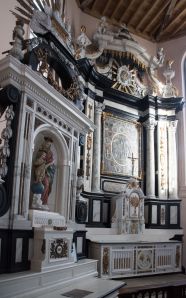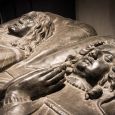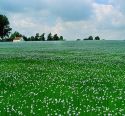Chapel | XVII | Gothic | Catholic Church


Map
Opening hours
01 January - 31 October
Mon
Tue
Wed
Thu
Fri
Sat
Sun
Chapel open for religious services, exhibitions and concerts.
Info : Centre Culturel de Jodoigne
Guided tour
+32 10 81 15 15
Religious offices
Thursday (except Ascension day) : 10.00 am
EgliseInfo
Description
The town is known for its centrally located chapel dedicated to Notre-Dame du Marché. The restoration, that started in 2008 and finished in 2011, restored the monument in all its glory.
The most striking element on the outside is without a doubt the spiral wind vane, an exceptional artefact in this region. The architect designed the wind vane to withstand the extreme winds on top of the tower. The massive tower can be seen from afar and stands out with its beautiful Gobertrange stones.
The chapel was recently partly desecrated. There is now also room for cultural activities such as exhibitions and concerts. The choir and the altar are still reserved for services. The painting of Our Lady of the Rosary is located at the centre of the altar. Statues of St. Roch and the Virgin and Child can be found on the side altars.
Retractable benches were installed in the nave to accommodate up to a hundred spectators. Panels that can be used for exhibitions were installed along the walls.
In an annex behind the choir, a cenotaph can be found. It is a memorial commemorating someone who is buried elsewhere. This cenotaph commemorates Count Winand de Glymes, former lord of Jodoigne, and his wive Michelle. They passed away respectively in 1668 and 1671. The couple is portrayed lying down with closed eyes and folded hands. The Count wears his armour. His helmet and gloves are places near his head.
Photos
Media
Remarkable elements
Rosary
The painting above the central altar, in the centre of the altarpiece, is dedicated entirely to the Virgin Mary. Notre-Dame du Rosaire, by an anonymous author, dates from the first quarter of the 17th century, surrounded by an 18th century frame. By various characteristics such as its composition, its academism, the rather frozen folds of the clothes, this work would belong to the Renaissance style. The central scene is surrounded by the 15 mysteries of the Rosary. They can be read clockwise, starting with the one at the top right. They are identified by the Latin text at the bottom of the scene.
Beam heads
The last restoration work on the chapel revealed sculpted beam ends in the octagonal volume at the top of the bell tower spire. These were placed at the base and top of this volume, forming each corner of it. These 16 elements, although eroded, are anthropomorphic or zoomorphic. The least damaged and most interesting sculpted heads (ten in number) are displayed in the recumbent room. These elements are all the more interesting as such examples are very rare in religious architecture.
Recumbents
The Market Chapel was a cemetery like many places of worship. Between 1668 and 1700, two great noble families from Jodoigne were buried there: the Glymes and the Escaille. Two tombstones with the names of these two lineages are still visible on the floor of the nave. In the "sacristy", a double recumbent represents very ideally Wynand de Glimes, Viscount of Jodoigne and his wife Michelle d'Yedeghem, who died respectively in 1668 and 1671. This high relief vault reproduces the typical shapes of medieval chandeliers and retains its various characteristics: the deceased are elongated, heads placed on a cushion and hands joined.
Stained glass window
The first level of the imposing square tower of the Chapelle Notre-Dame du Marché has a doorway preceded by three blue stone steps. The arch of the door is in a basket handle, surmounted by a large Gothic bay with flamboyant fillings, probably from the 15th century. At the base of the stained glass window of this ogival bay is a statuette of the Virgin Mary, reminding us that the chapel was dedicated to her on August 12, 1353.
The Virgin Mary
This white stone statuette is the work of the stonemason Liesse on a plaster model by Lydia D'Aoust. This statute of Mary Immaculate is covered with a veil, the left hand placed on her heart and in her right hand, she holds a scroll with the inscription: A.M. 1954 (Marian Year 1954).
The tower and the bell tower
the square tower is about 27 metres high, made entirely of local stone: the white Gobertange stone extracted in the Mélin region. This is the oldest part of the Chapel, consecrated in 1353. The tower is divided into 4 levels. The last two levels and the spire were rebuilt between 1634 and 1637. It is during this restoration that the bell tower is given its original twisted shape, remarkable and exceptional in Brabant. This twisted or flamed bell tower has a spiral spire, covered with slates and finished with a polygonal bell tower. This helical work is explained by a desire to avoid prevailing winds.
Sainte-Marie / Dames de choeur - campagne 2021
Sous la remarquable et rare flèche en forme d’hélice de la chapelle Notre-Dame du Marché à Jodoigne se cachent divers hommage à la Vierge Marie.

























